Abstract
OBJECTIVE--To analyse the relation between symptoms regularly reported by hospital personnel and exposure to anaesthetics. SETTING--Personnel of 18 hospitals in Paris from 1987 to 1989. DESIGN--An exposed group that included all operating theatre members except for doctors, and which was divided into three subgroups depending on the degree of exposure--exposure was measured by the frequency of the use of the scavenging system--and a control group that included other hospital personnel matched by hospital, sex, occupation, age, and duration of service. SUBJECTS--557 exposed workers and 566 unexposed workers. MAIN OUTCOME MEASURES--The groups were compared according to the crude rates of regular symptoms. Adjusted odds ratios were calculated to estimate the risks associated with exposure to anaesthetic gas. Liver transaminase activities (alanine aminotransferase, aspartate aminotransferase (s-ASAT, and gamma-glutamyl transpeptidase) were measured and compared between groups of exposure. RESULTS--After controlling for working conditions and matching factors, neuropsychological symptoms and tiredness were reported more by workers in less often scavenged theatres than by controls. No difference was found between workers of the well scavenged theatres and controls. Among the exposed workers, the members of paediatric surgical staffs reported a higher rate of neurological complaints (tingling, numbness, cramps) and tiredness than the members of the other surgical staffs. They had a high value of s-ASAT more frequently than the other exposed workers. CONCLUSION--These results strengthen the hypothesis of a causal relation between exposure to anaesthetics and neuropsychological symptoms, and show a dose-response effect. They suggest that the use of ventilating systems in operating rooms is an effective means of prevention.
Full text
PDF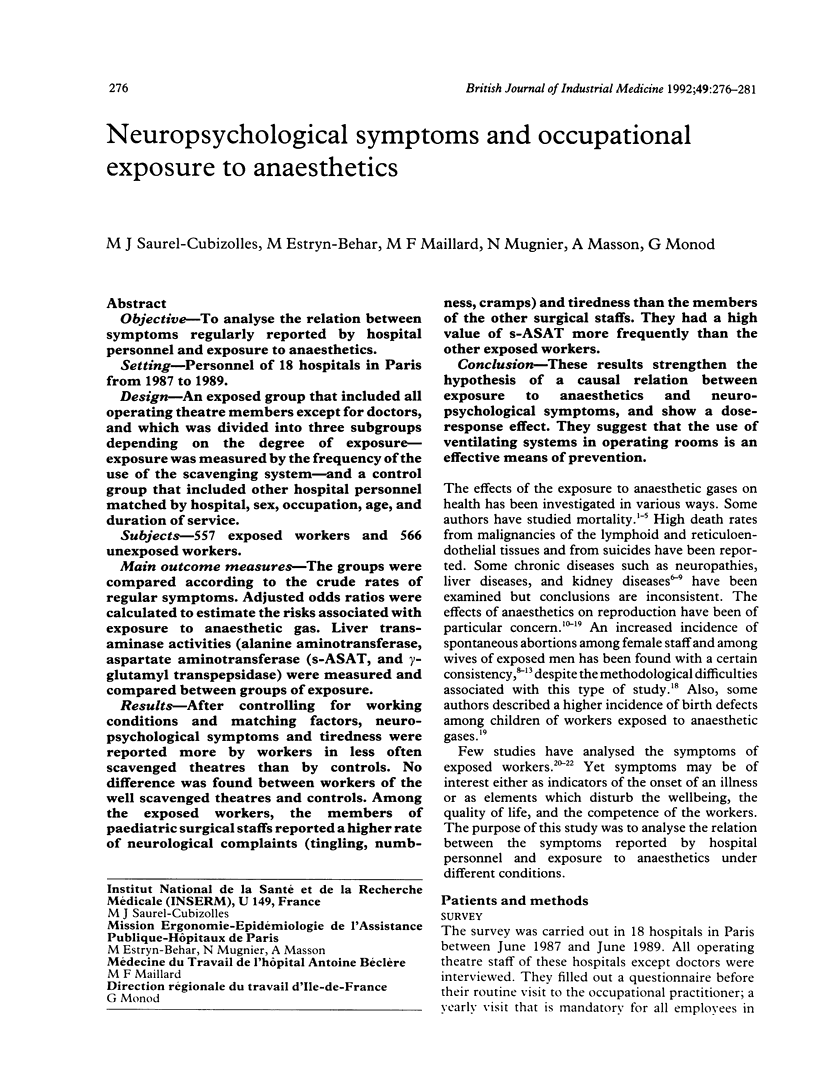
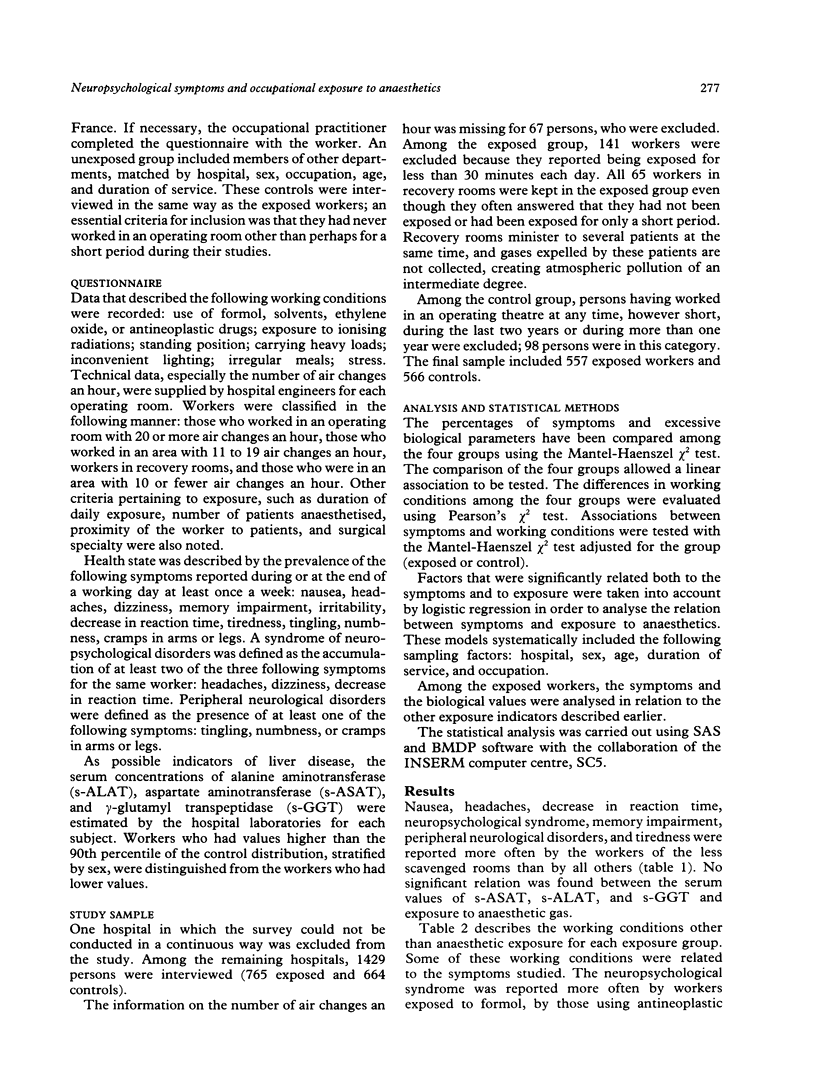
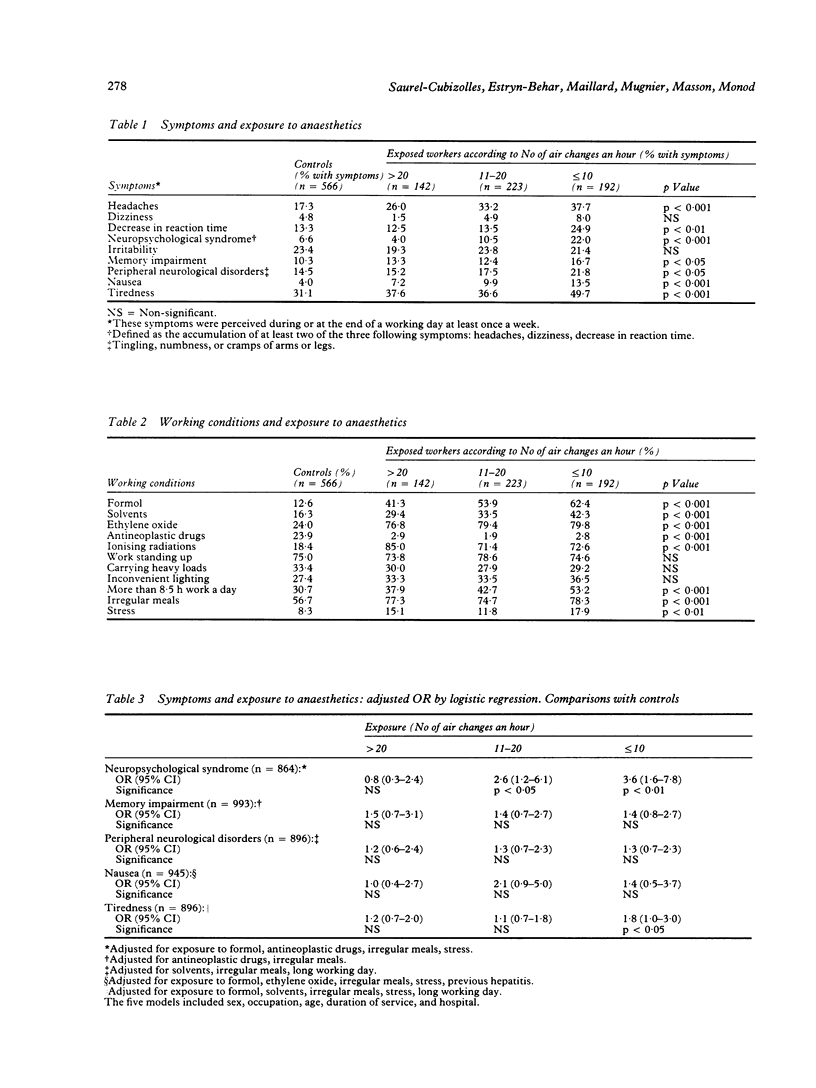
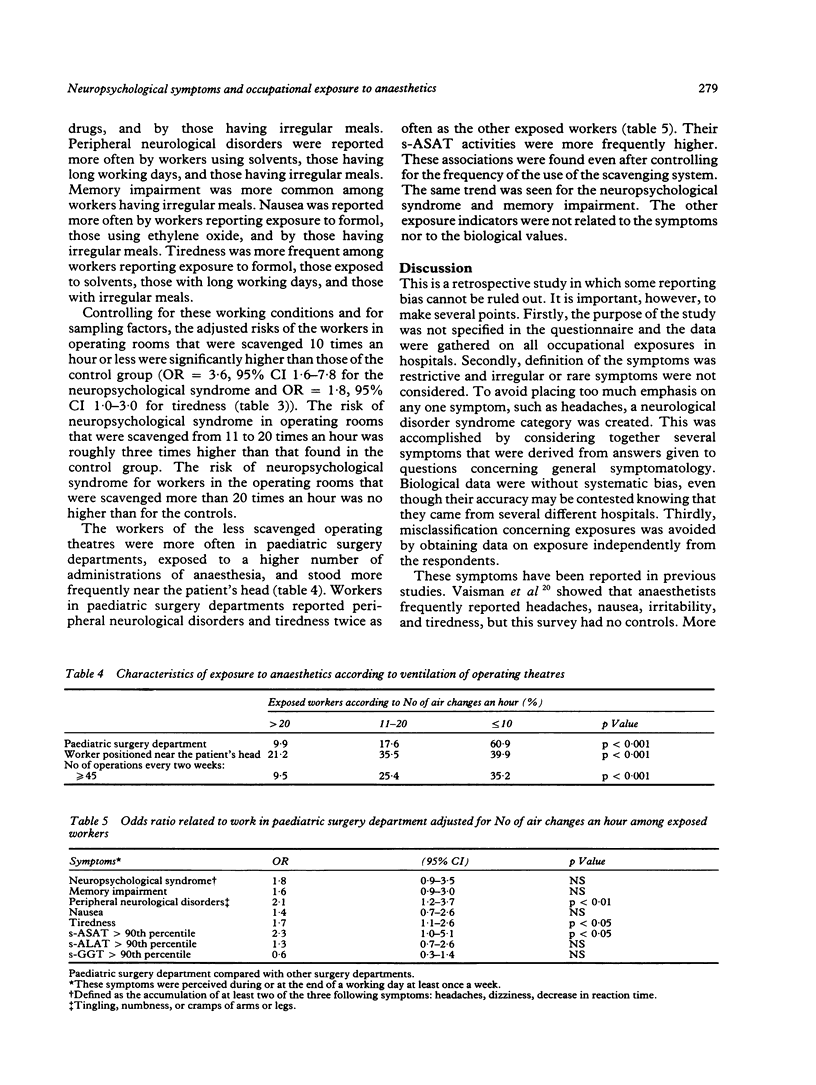
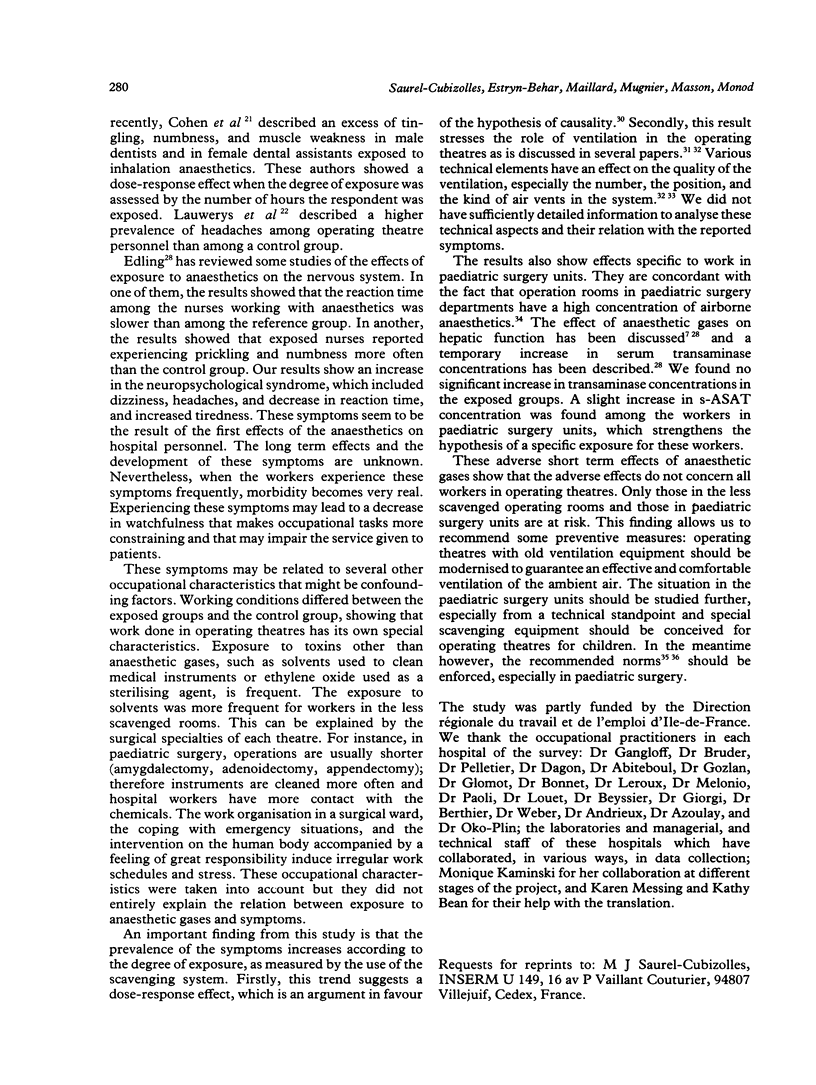
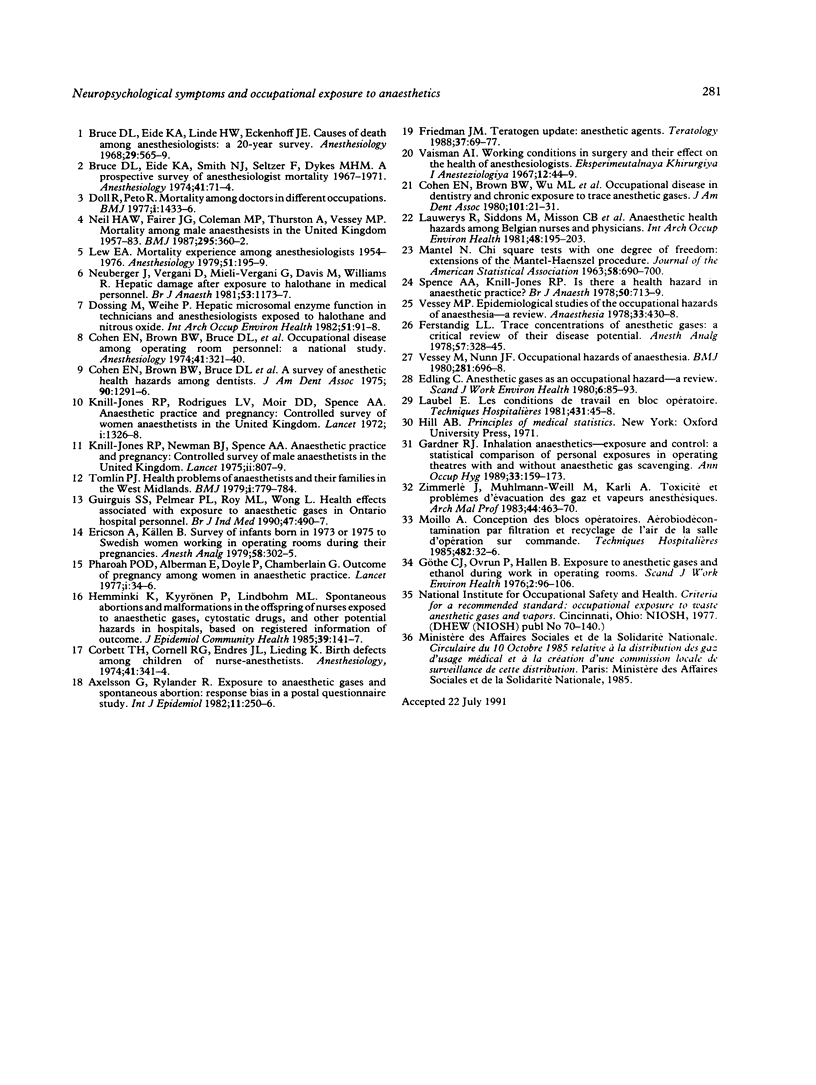
Selected References
These references are in PubMed. This may not be the complete list of references from this article.
- Axelsson G., Rylander R. Exposure to anaesthetic gases and spontaneous abortion: response bias in a postal questionnaire study. Int J Epidemiol. 1982 Sep;11(3):250–256. doi: 10.1093/ije/11.3.250. [DOI] [PubMed] [Google Scholar]
- Bruce D. L., Eide K. A., Linde H. W., Eckenhoff J. E. Causes of death among anesthesiologists: a 20-year survey. Anesthesiology. 1968 May-Jun;29(3):565–569. doi: 10.1097/00000542-196805000-00039. [DOI] [PubMed] [Google Scholar]
- Bruce D. L., Eide K. A., Smith N. J., Seltzer F., Dykes M. H. A prospective survey of anesthesiologist mortality, 1967-1971. Anesthesiology. 1974 Jul;41(1):71–74. doi: 10.1097/00000542-197407000-00017. [DOI] [PubMed] [Google Scholar]
- Cohen E. N., Brown B. W., Jr, Bruce D. L., Cascorbi H. F., Corbett T. H., Jones T. W., Whitcher C. E. A survey of anesthetic health hazards among dentists. J Am Dent Assoc. 1975 Jun;90(6):1291–1296. doi: 10.14219/jada.archive.1975.0270. [DOI] [PubMed] [Google Scholar]
- Cohen E. N., Gift H. C., Brown B. W., Greenfield W., Wu M. L., Jones T. W., Whitcher C. E., Driscoll E. J., Brodsky J. B. Occupational disease in dentistry and chronic exposure to trace anesthetic gases. J Am Dent Assoc. 1980 Jul;101(1):21–31. doi: 10.14219/jada.archive.1980.0345. [DOI] [PubMed] [Google Scholar]
- Corbett T. H., Cornell R. G., Endres J. L., Lieding K. Birth defects among children of nurse-anesthetists. Anesthesiology. 1974 Oct;41(4):341–344. [PubMed] [Google Scholar]
- Doll R., Peto R. Mortality among doctors in different occupations. Br Med J. 1977 Jun 4;1(6074):1433–1436. doi: 10.1136/bmj.1.6074.1433. [DOI] [PMC free article] [PubMed] [Google Scholar]
- Døssing M., Weihe P. Hepatic microsomal enzyme function in technicians and anesthesiologists exposed to halothane and nitrous oxide. Int Arch Occup Environ Health. 1982;51(1):91–98. doi: 10.1007/BF00378414. [DOI] [PubMed] [Google Scholar]
- Edling C. Anesthetic gases as an occupational hazard--a review. Scand J Work Environ Health. 1980 Jun;6(2):85–93. doi: 10.5271/sjweh.2626. [DOI] [PubMed] [Google Scholar]
- Ericson A., Källén B. Survey of infants born in 1973 or 1975 to Swedish women working in operating rooms during their pregnancies. Anesth Analg. 1979 Jul-Aug;58(4):302–305. doi: 10.1213/00000539-197907000-00008. [DOI] [PubMed] [Google Scholar]
- Ferstandig L. L. Trace concentrations of anesthetic gases: a critical review of their disease potential. Anesth Analg. 1978 May-Jun;57(3):328–345. doi: 10.1213/00000539-197805000-00009. [DOI] [PubMed] [Google Scholar]
- Friedman J. M. Teratogen update: anesthetic agents. Teratology. 1988 Jan;37(1):69–77. doi: 10.1002/tera.1420370111. [DOI] [PubMed] [Google Scholar]
- Gardner R. J. Inhalation anaesthetics--exposure and control: a statistical comparison of personal exposures in operating theatres with and without anaesthetic gas scavenging. Ann Occup Hyg. 1989;33(2):159–173. doi: 10.1093/annhyg/33.2.159. [DOI] [PubMed] [Google Scholar]
- Guirguis S. S., Pelmear P. L., Roy M. L., Wong L. Health effects associated with exposure to anaesthetic gases in Ontario hospital personnel. Br J Ind Med. 1990 Jul;47(7):490–497. doi: 10.1136/oem.47.7.490. [DOI] [PMC free article] [PubMed] [Google Scholar]
- Göthe C. J., Ovrum P., Hallen B. Exposure to anesthetic gases and ethanol during work in operating rooms. Scand J Work Environ Health. 1976 Jun;2(2):96–106. doi: 10.5271/sjweh.2814. [DOI] [PubMed] [Google Scholar]
- Hemminki K., Kyyrönen P., Lindbohm M. L. Spontaneous abortions and malformations in the offspring of nurses exposed to anaesthetic gases, cytostatic drugs, and other potential hazards in hospitals, based on registered information of outcome. J Epidemiol Community Health. 1985 Jun;39(2):141–147. doi: 10.1136/jech.39.2.141. [DOI] [PMC free article] [PubMed] [Google Scholar]
- Knill-Jones R. P., Newman B. J., Spence A. A. Anesthetic practice and pregnancy. Controlled survey of male anaesthetists in the United Kingdom. Lancet. 1975 Oct 25;2(7939):807–809. [PubMed] [Google Scholar]
- Knill-Jones R. P., Rodrigues L. V., Moir D. D., Spence A. A. Anaesthetic practice and pregnancy. Controlled survey of women anaesthetists in the United Kingdom. Lancet. 1972 Jun 17;1(7764):1326–1328. doi: 10.1016/s0140-6736(72)91048-3. [DOI] [PubMed] [Google Scholar]
- Lauwerys R., Siddons M., Misson C. B., Borlee I., Bouckaert A., Lechat M. F., De Temmerman P. Anaesthetic health hazards among Belgian nurses and physicians. Int Arch Occup Environ Health. 1981;48(2):195–203. doi: 10.1007/BF00378441. [DOI] [PubMed] [Google Scholar]
- Lew E. A. Mortality experience among anesthesiologists, 1954-1976. Anesthesiology. 1979 Sep;51(3):195–199. doi: 10.1097/00000542-197909000-00003. [DOI] [PubMed] [Google Scholar]
- Neil H. A., Fairer J. G., Coleman M. P., Thurston A., Vessey M. P. Mortality among male anaesthetists in the United Kingdom, 1957-83. Br Med J (Clin Res Ed) 1987 Aug 8;295(6594):360–362. doi: 10.1136/bmj.295.6594.360. [DOI] [PMC free article] [PubMed] [Google Scholar]
- Neuberger J., Vergani D., Mieli-Vergani G., Davis M., Williams R. Hepatic damage after exposure to halothane in medical personnel. Br J Anaesth. 1981 Nov;53(11):1173–1177. doi: 10.1093/bja/53.11.1173. [DOI] [PubMed] [Google Scholar]
- Occupational disease among operating room personnel: a national study. Report of an Ad Hoc Committee on the Effect of Trace Anesthetics on the Health of Operating Room Personnel, American Society of Anesthesiologists. Anesthesiology. 1974 Oct;41(4):321–340. [PubMed] [Google Scholar]
- Pharoah P. O., Alberman E., Doyle P., Chamberlain G. Outcome of pregnancy among women in anaesthetic practice. Lancet. 1977 Jan 1;1(8001):34–36. doi: 10.1016/s0140-6736(77)91666-x. [DOI] [PubMed] [Google Scholar]
- Spence A. A., Knill-Jones R. P. Is there a health hazard in anaesthetic practice? Br J Anaesth. 1978 Jul;50(7):713–719. doi: 10.1093/bja/50.7.713. [DOI] [PubMed] [Google Scholar]
- Tomlin P. J. Health problems of anaesthetists and their families in the West Midlands. Br Med J. 1979 Mar 24;1(6166):779–784. doi: 10.1136/bmj.1.6166.779. [DOI] [PMC free article] [PubMed] [Google Scholar]
- Vessey M. P. Epidemiological studies of the occupational hazards of anaesthesia--a review. Anaesthesia. 1978 May;33(5):430–438. doi: 10.1111/j.1365-2044.1978.tb12461.x. [DOI] [PubMed] [Google Scholar]
- Vessey M. P., Nunn J. F. Occupational hazards of anesthesia. Br Med J. 1980 Sep 13;281(6242):696–698. doi: 10.1136/bmj.281.6242.696. [DOI] [PMC free article] [PubMed] [Google Scholar]


